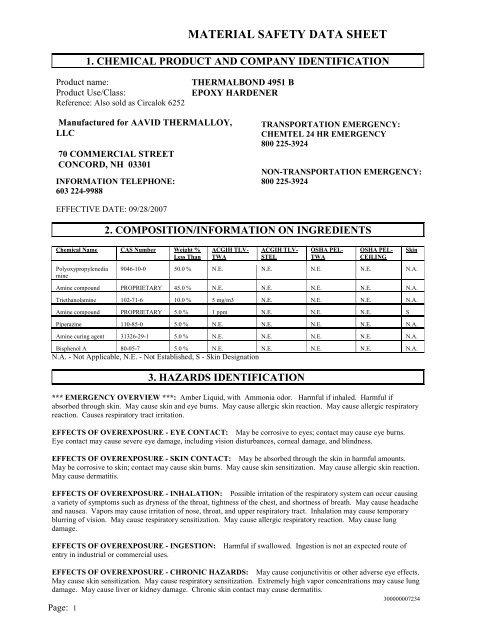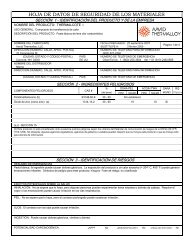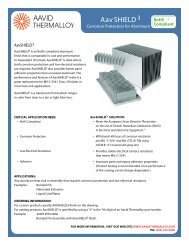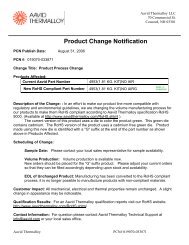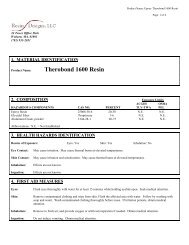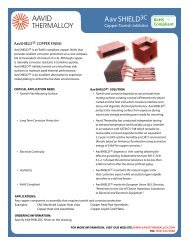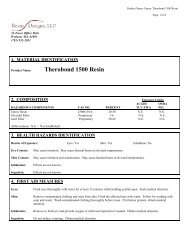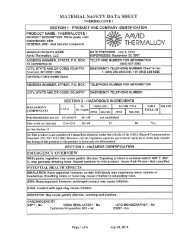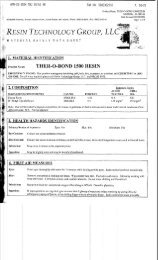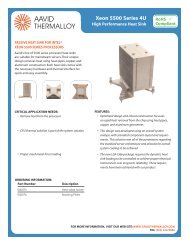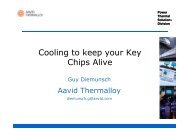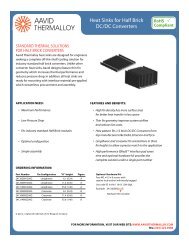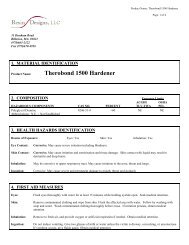MATERIAL SAFETY DATA SHEET - Aavid
MATERIAL SAFETY DATA SHEET - Aavid
MATERIAL SAFETY DATA SHEET - Aavid
You also want an ePaper? Increase the reach of your titles
YUMPU automatically turns print PDFs into web optimized ePapers that Google loves.
<strong>MATERIAL</strong> <strong>SAFETY</strong> <strong>DATA</strong> <strong>SHEET</strong><br />
1. CHEMICAL PRODUCT AND COMPANY IDENTIFICATION<br />
Product name: THERMALBOND 4951 B<br />
Product Use/Class: EPOXY HARDENER<br />
Reference: Also sold as Circalok 6252<br />
Manufactured for AAVID THERMALLOY,<br />
LLC<br />
70 COMMERCIAL STREET<br />
CONCORD, NH 03301<br />
INFORMATION TELEPHONE:<br />
603 224-9988<br />
EFFECTIVE DATE: 09/28/2007<br />
TRANSPORTATION EMERGENCY:<br />
CHEMTEL 24 HR EMERGENCY<br />
800 225-3924<br />
NON-TRANSPORTATION EMERGENCY:<br />
800 225-3924<br />
2. COMPOSITION/INFORMATION ON INGREDIENTS<br />
Chemical Name CAS Number Weight %<br />
Less Than<br />
Polyoxypropylenedia<br />
mine<br />
ACGIH TLV-<br />
TWA<br />
ACGIH TLV-<br />
STEL<br />
OSHA PEL-<br />
TWA<br />
OSHA PEL-<br />
CEILING<br />
9046-10-0 50.0 % N.E. N.E. N.E. N.E. N.A.<br />
Amine compound PROPRIETARY 45.0 % N.E. N.E. N.E. N.E. N.A.<br />
Triethanolamine 102-71-6 10.0 % 5 mg/m3 N.E. N.E. N.E. N.A.<br />
Amine compound PROPRIETARY 5.0 % 1 ppm N.E. N.E. N.E. S<br />
Piperazine 110-85-0 5.0 % N.E. N.E. N.E. N.E. N.A.<br />
Amine curing agent 31326-29-1 5.0 % N.E. N.E. N.E. N.E. N.A.<br />
Bisphenol A 80-05-7 5.0 % N.E. N.E. N.E. N.E. N.A.<br />
N.A. - Not Applicable, N.E. - Not Established, S - Skin Designation<br />
3. HAZARDS IDENTIFICATION<br />
*** EMERGENCY OVERVIEW ***: Amber Liquid, with Ammonia odor. Harmful if inhaled. Harmful if<br />
absorbed through skin. May cause skin and eye burns. May cause allergic skin reaction. May cause allergic respiratory<br />
reaction. Causes respiratory tract irritation.<br />
EFFECTS OF OVEREXPOSURE - EYE CONTACT: May be corrosive to eyes; contact may cause eye burns.<br />
Eye contact may cause severe eye damage, including vision disturbances, corneal damage, and blindness.<br />
EFFECTS OF OVEREXPOSURE - SKIN CONTACT: May be absorbed through the skin in harmful amounts.<br />
May be corrosive to skin; contact may cause skin burns. May cause skin sensitization. May cause allergic skin reaction.<br />
May cause dermatitis.<br />
EFFECTS OF OVEREXPOSURE - INHALATION: Possible irritation of the respiratory system can occur causing<br />
a variety of symptoms such as dryness of the throat, tightness of the chest, and shortness of breath. May cause headache<br />
and nausea. Vapors may cause irritation of nose, throat, and upper respiratory tract. Inhalation may cause temporary<br />
blurring of vision. May cause respiratory sensitization. May cause allergic respiratory reaction. May cause lung<br />
damage.<br />
EFFECTS OF OVEREXPOSURE - INGESTION: Harmful if swallowed. Ingestion is not an expected route of<br />
entry in industrial or commercial uses.<br />
EFFECTS OF OVEREXPOSURE - CHRONIC HAZARDS: May cause conjunctivitis or other adverse eye effects.<br />
May cause skin sensitization. May cause respiratory sensitization. Extremely high vapor concentrations may cause lung<br />
damage. May cause liver or kidney damage. Chronic skin contact may cause dermatitis.<br />
300000007234<br />
Page: 1<br />
Skin
Product: THERMALBOND 4951 B, Effective Date: 09/28/2007<br />
PRIMARY ROUTE(S) OF ENTRY: Skin Contact, Skin Absorption, Inhalation, Ingestion, Eye Contact<br />
Page: 2<br />
4. FIRST AID MEASURES<br />
FIRST AID - EYE CONTACT: Flush eyes immediately with large amount of water for at least 15 minutes holding<br />
eyelids open while flushing. Get prompt medical attention.<br />
FIRST AID - SKIN CONTACT: Flush contaminated skin with large amounts of water while removing contaminated<br />
clothing. Wash affected skin areas with soap and water. Get medical attention if symptoms occur.<br />
FIRST AID - INHALATION: Move person to fresh air. Restore and support continued breathing. If breathing is<br />
difficult, give oxygen. Get immediate medical attention.<br />
FIRST AID - INGESTION: If swallowed, do not induce vomiting. Give victim one or two glasses of water or milk.<br />
Call a physician or poison control center immediately for further instructions. Never give anything by mouth if victim is<br />
rapidly losing consciousness, unconscious or convulsing.<br />
5. FIRE-FIGHTING MEASURES<br />
FLASH POINT: 201 °F, 93 °C LOWER EXPLOSIVE LIMIT (%): Not Applicable<br />
Setaflash Closed Cup UPPER EXPLOSIVE LIMIT (%): Not Applicable<br />
AUTOIGNITION TEMPERATURE: N.D.<br />
EXTINGUISHING MEDIA: Carbon Dioxide, Dry Chemical, Foam, Water Fog<br />
UNUSUAL FIRE AND EXPLOSION HAZARDS: Keep containers tightly closed. Closed containers may rupture<br />
when exposed to extreme heat. Use water spray to keep fire exposed containers cool. During a fire, irritating and/or<br />
toxic gases and particulate may be generated by thermal decomposition or combustion.<br />
SPECIAL FIREFIGHTING PROCEDURES: Wear full firefighting protective clothing, including self-contained<br />
breathing apparatus (SCBA). If water is used, fog nozzles are preferable.<br />
6. ACCIDENTAL RELEASE MEASURES<br />
STEPS TO BE TAKEN IN CASE <strong>MATERIAL</strong> IS RELEASED OR SPILLED: Keep non-essential personnel a<br />
safe distance away from the spill area. Avoid breathing vapors. Use self-contained breathing equipment. Notify<br />
appropriate authorities if necessary. Avoid contact. Before attempting cleanup, refer to hazard caution information in<br />
other sections of the MSDS form. Scoop spilled material into an appropriate container for proper disposal. (If necessary,<br />
use inert absorbent material to aid in containing the spill).<br />
7. HANDLING AND STORAGE<br />
HANDLING: Keep closure tight and container upright to prevent leakage. Avoid skin and eye contact. Wash<br />
thoroughly after handling. Avoid breathing of vapor or spray mists. Do not handle until all safety precautions have been<br />
read and understood. Empty containers should not be re-used. Use with adequate ventilation.<br />
STORAGE: Store only in well-ventilated areas. Keep container closed when not in use.<br />
8. EXPOSURE CONTROLS / PERSONAL PROTECTION<br />
ENGINEERING CONTROLS: Sufficient ventilation in pattern and volume should be provided in order to maintain<br />
air contaminant levels below recommended exposure limits.<br />
RESPIRATORY PROTECTION: Use a NIOSH approved air-purifying organic vapor respirator if occupational<br />
limits are exceeded. For emergency situations, confined space use, or other conditions where exposure limits may be
Product: THERMALBOND 4951 B, Effective Date: 09/28/2007<br />
greatly exceeded, use an approved air-supplied respirator. Observe OSHA regulations (29CFR 1910.134) for respirator<br />
use.<br />
SKIN PROTECTION: Use neoprene, nitrile, or rubber gloves to prevent skin contact.<br />
EYE PROTECTION: Use safety eyewear including safety glasses with side shields and chemical goggles where<br />
splashing may occur.<br />
OTHER PROTECTIVE EQUIPMENT: Remove and wash contaminated clothing before reuse.<br />
HYGIENIC PRACTICES: Wash hands before eating, smoking, or using toilet facility. Food or beverages should not<br />
be consumed anywhere this product is handled or stored. Wash thoroughly after handling.<br />
Page: 3<br />
9. PHYSICAL AND CHEMICAL PROPERTIES<br />
ODOR: Ammonia BOILING RANGE: 290 °F - 680 °F<br />
APPEARANCE: Amber VAPOR PRESSURE: N.D.<br />
PHYSICAL STATE: Liquid VAPOR DENSITY: Heavier than Air<br />
ODOR THRESHOLD: N.D. EVAPORATION RATE: Not Applicable<br />
SOLUBILITY IN H2O: Insoluble DENSITY, LB/GL: 8.2059 lb/gal<br />
pH: N.A. VOLATILE BY WEIGHT: 0.00 %<br />
FREEZE POINT: N.D. VOLATILE BY VOLUME: 0.00 %<br />
COEFFICIENT OF WATER/OIL<br />
DISTRIBUTION:<br />
N.D.<br />
(See section 16 for abbreviation legend)<br />
CONDITIONS TO AVOID: High temperatures.<br />
10. STABILITY AND REACTIVITY<br />
INCOMPATIBILITY: Strong acids, bases, and strong oxidizers.<br />
HAZARDOUS DECOMPOSITION PRODUCTS: Carbon monoxide, carbon dioxide, organic or inorganic nitrogen<br />
compounds including traces of hydrogen cyanide.<br />
HAZARDOUS POLYMERIZATION: Hazardous polymerization will not occur under normal conditions.<br />
STABILITY: Product is stable under normal storage conditions.<br />
11. TOXICOLOGICAL INFORMATION<br />
PRODUCT LD50 (ORAL) No Data<br />
(DERMAL) No Data<br />
PRODUCT LC50 No Data<br />
ECOLOGICAL INFORMATION: No Information<br />
12. ECOLOGICAL INFORMATION<br />
13. DISPOSAL CONSIDERATIONS<br />
DISPOSAL METHOD: Disposal should be done in accordance with Federal (40CFR Part 261), state and local<br />
environmental control regulations. If waste is determined to be hazardous, use licensed hazardous waste transporter and<br />
disposal facility.<br />
14. TRANSPORT INFORMATION
Product: THERMALBOND 4951 B, Effective Date: 09/28/2007<br />
DOT PROPER SHIPPING NAME: Amines, liquid, corrosive, n.o.s.<br />
DOT HAZARD CLASS: 8<br />
SECONDARY HAZARD: None<br />
DOT UN/NA NUMBER: 2735<br />
PACKING GROUP: III<br />
EMERGENCY RESPONSE GUIDE 153<br />
NUMBER:<br />
The listed transportation classification applies to US DOT non-bulk road shipments. It does not address regulatory<br />
variations due to changes in package size, mode of shipment or other regulatory descriptors. For the most accurate<br />
shipping information, refer to your transportation/compliance department.<br />
U.S. FEDERAL REGULATIONS: AS FOLLOWS -<br />
Page: 4<br />
15. REGULATORY INFORMATION<br />
This product is considered hazardous as defined by 29 CFR 1910.1200 (OSHA HazCom Standard.)<br />
SARA SECTION 313<br />
This product contains the following substances subject to the reporting requirements of Section 313 of Title III of the<br />
Superfund Amendment and Reauthorization Act of 1986 and 40 CFR part 372:<br />
Chemical Name CAS Number Weight % Less Than<br />
Bisphenol A 80-05-7 5.0 %<br />
TOXIC SUBSTANCES CONTROL ACT:<br />
INVENTORY STATUS<br />
The chemical substances in this product are on the TSCA Section 8 Inventory.<br />
EXPORT NOTIFICATION<br />
This product contains the following chemical substances subject to the reporting requirements of TSCA 12(B) if<br />
exported from the United States:<br />
NONE<br />
16. OTHER INFORMATION<br />
HMIS RATINGS - HEALTH: 3* FLAMMABILITY: 1 PHYSICAL HAZARD: 1<br />
* - Indicates a chronic hazard; see Section 3<br />
VOLATILE ORGANIC COMPOUNDS<br />
Calculated 0 lb/gal, 0 g/l<br />
LEGEND: N.A. - Not Applicable, N.E. - Not Established, N.D. - Not Determined<br />
DISCLAIMER<br />
The information contained herein is, to the best of our knowledge and belief, accurate. However, since the conditions of<br />
handling and use are beyond our control, we make no guarantee of results, and assume no liability for damages incurred<br />
by use of this material. It is the responsibility of the user to comply with all applicable federal, state and local laws and<br />
regulations.


